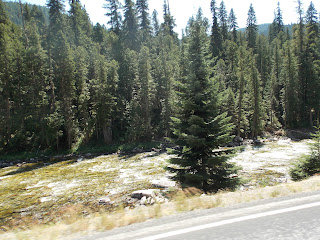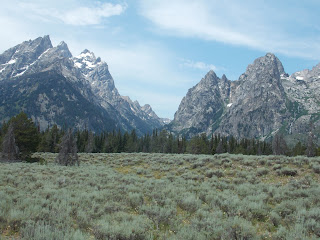We visited the other half of Hell's Half Acre! Well, the area of Craters of the Moon is a bit more than half of an acre, like about 750 thousand acres. The land here in southeastern Idaho does have a connection, however with Hell's Half Acre as well as Yellowstone. The Snake River Plain extends across southern Idaho in a 400 mile arc, one of the largest volcanic regions in the earth. Its geologic features indicate that about 16 million years ago the volcanic activity began and continues today in the geysers and hot springs of Yellowstone. Craters of the Moon represent the most recent eruptions, which occurred only 2,000 years ago. First scientific proof of the age of that flow was found in the growth rings of the core of a limber pine, which took root after the lava cooled. Age of the tree was estimated to be about 1,350 years old. Oral traditions of Native Americans also tell of a time when the lava flowed.

The eruption at Craters of the Moon was similar to Hell's Half Acre- vast amounts of lava issued not from one volcano, but from a series of deep fissures known collectively as the Great Rift. However, here the eruptions were of a more moderate strength, strong enough to throw up cinders into the air, and these cinders built up into fairly large cones. John and I climbed Inferno Cone to view a row of cinder cones which make up a part of the Great Rift. The tallest cone in the monument, Big Cinder Butte, is 700 feet high.

As we found at Hell's Half Acre, the lava fields do eventually sprout life, called cinder gardens. Lichen breaks the rock down into soil, and soil is also brought in by the wind. Desert-tolerant plants take root and life begins. We saw cones dotted with the white-colored dwarf buckwheat, and, on one side of Inferno Cone, we found a patch of blazing star. It reminded me of Cinderella sitting among ashes. Most of the plants grow with such regular spacing that we wondered whether someone planted them. However, we later learned from the park's brochures, that regular spacing occurs because each plant competes for water through their extensive root system. That spacing is needed for survival.

Unfortunately we did not catch the plant at its prettiest moment, its blooms open only at night. If we thought finding a pretty flower in this barren hot land was strange, how about finding a patch of snow? We climbed a splatter cone (cones made by clots of lava paste instead of cinders) and peered into its vent.
That is a patch of snow! Craters of the Moon certainly had many surprises for us. It is an interesting land, but not one where anyone would choose to live. In the past Native Americans and pioneers would only pass through it, not choosing to live there because of the lava terrain and lack of water. Astronauts visited it thinking that the harsh alien environment would give them a feel for the geologic features of the moon. I will conclude this with one final picture. In my last posting I had a picture of ropey coil of lava, pictured below is a better picture of that type of lava flow. In the background are fragments of a crater wall.
















































